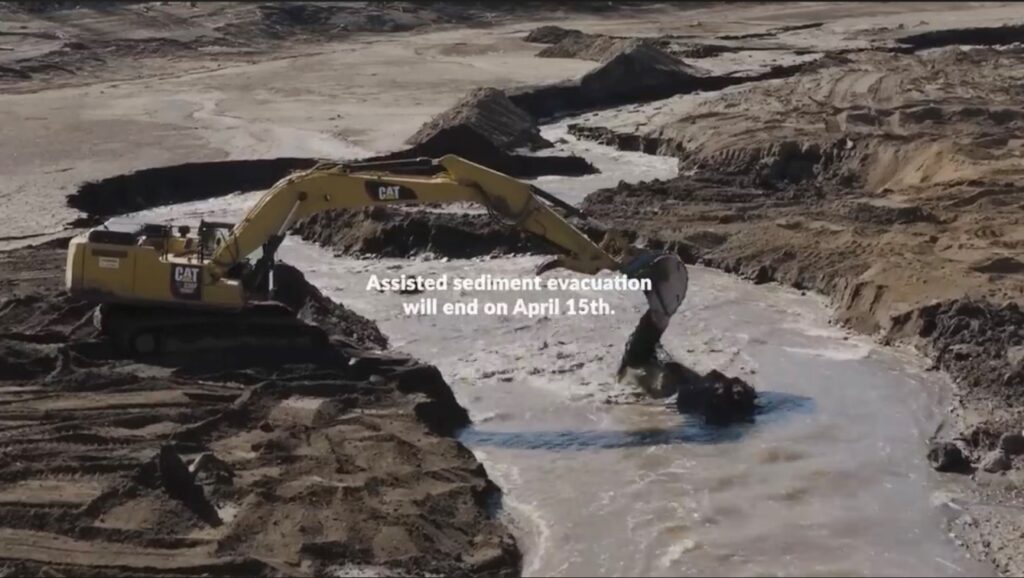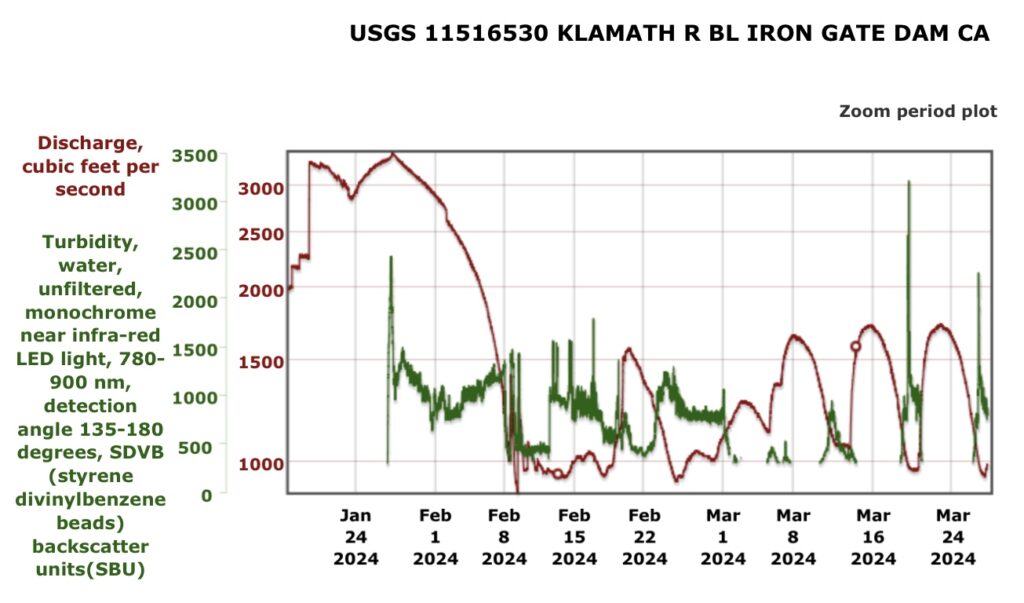The final steps in Klamath River dam removal are complete, and the first salmon has migrated upstream into the dam-removal reach in over 100 years. The four reservoirs were drained last winter and the dams removed this summer. The river is now free in its natural channel. Two dams remain up at Klamath Lake (Keno and Link dams – not part of the project), but the lower four hydroelectric project dams – three in Oregon and one in California – are gone. With the demolition of the last of these lower four dams this summer, the Klamath is running free from its headwaters in southeastern Oregon to its mouth in the Pacific Ocean on Yurok tribal lands in northwestern California. Hundreds of miles of spawning grounds are open to Chinook salmon, Coho salmon, and steelhead for the first time in more than a century.
The dam-removal process was not without problems, although these problems were generally foreseen in planning and permitting. First was the reservoir draining process this past winter, when the reservoirs were drained, from mid-January to mid-February. In the four-dam reach and in the Klamath River downstream, high suspended fine sediment and low dissolved oxygen were problems, though determined of limited risk to the few salmon and steelhead in the river at that time. However, the Assisted Sediment Evacuation project element (Figure 1) continued past its prescribed end date of March 15 into early April, extending the presence of lethal levels of suspended sediment into the early juvenile salmon and steelhead emigration season from tributaries, a season that includes March. Lethal levels of suspended sediment extended downstream over 100 miles as far as Orleans (Figures 2 and 3).
Subsequently, during the summer, dam infrastructure was removed to provide full salmon passage past the dam sites. Low flows necessary to access the dam sites for material removal, and high summer air temperatures, resulted in very warm water temperatures beginning in July. Removal of coffer dams and further Assistant Sediment Evacuation at the dam sites (Figure 4) led to the return of lethal sediment levels in the river below Iron Gate (see Figure 2). On three days, dissolved oxygen below Iron Gate reached zero.
Though approved by the project technical team, the high suspended sediment level through September likely hindered a major portion of the fall-run Chinook salmon run up the Klamath River (Figure 5). Only 60 adult salmon were reported at the Shasta River trap as of early October, by which time daily numbers are usually in the hundreds. Numbers at other traps at other tributaries were even lower, which perhaps explains why only one salmon has been seen at the new sonar station above the Iron Gate Dam site.
With the cessation of Assisted Sediment Evacuation at the end of September, the hope is that suspended sediment levels will return to the low pre-summer levels and fall-run Chinook salmon will recommence their migration upriver. The river should be clear for late fall and winter runs of coho salmon and steelhead.
The use of Assisted Sediment Evacuation in winter and early spring, and then again in late summer, will remain controversial, if only in that it was applied under an extended time frame from the original planning and permitting documents. The summer application was certainly a surprise to local stakeholders,1 who were shocked by the extent and duration of the muddy and smelly river conditions. A condition of zero dissolved oxygen for 50 miles below Iron Gate dam for two days in September was not approved under the permits issued by the state or federal governments.
In my opinion, the initial and final evacuation of muddy sediment should not have been implemented by using excavators to dump sediment directly into the river. A better option would have been natural removal by winter storm events that would have provided a much higher dilution factor and would have had a better chance for a non-lethal concentration of suspended sediment. Furthermore, more of the sediment should have been removed or stored in upper terraces and not allowed to enter the river.
The NOAA Fisheries final assessment of the dam removal effort failed to acknowledge the problems and potential consequences of the spring or summer events.
“Heavy equipment removed the final obstacle separating the Klamath River from the Pacific Ocean on Tuesday. The reconnected river was turbid but remained safe for fish after crews took steps to avoid erosion and impacts to water quality.” The river was not safe for salmon or steelhead for over 100 miles downstream.
“Crews used a strategy of releasing sediment and organic material that muddied the river but avoided a decline in dissolved oxygen that could have otherwise harmed fish.” Untrue. Both dissolved oxygen and suspended sediment levels were lethal. Hopefully, many fish were able to avoid these conditions.





- See Facebook (Klamath River & Dam Removals) ↩

















